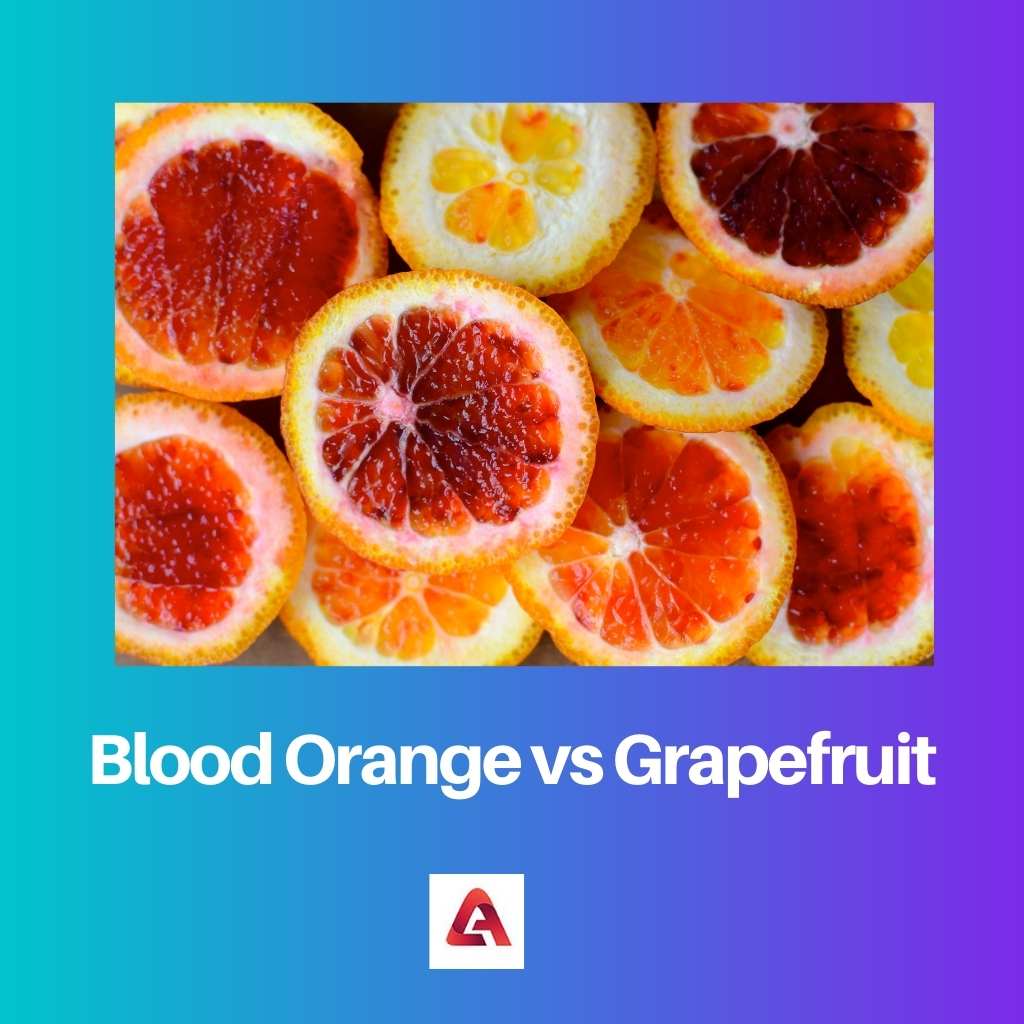Oranges and grapefruits, in particular, are well known for having unique flavours. Even though blood oranges have an acidic flavour, they also have a sweet taste.
Its flavour is a mix of various tangy flavours and gives an aftertaste too. On the other hand, the bitterness of grapefruit is well-known in the industry.
Key Takeaways
- Blood oranges have a deep red flesh and a sweet, slightly tart flavor with raspberry notes.
- Grapefruits are larger citrus fruits with yellow or pink flesh and a tart, slightly bitter flavor.
- Blood oranges are used for their unique color and flavor in desserts and salads, while grapefruits are commonly consumed fresh, juiced, or used in various dishes.
Blood Orange vs Grapefruit
Blood orange is a type of orange that has a deep crimson, almost blood-coloured flesh, is smaller than regular oranges and has a distinctive sweet-tart taste with raspberry-like notes. Grapefruit is a subtropical citrus fruit larger than an orange with yellow or pinkish flesh.

Blood orange is a kind of orange that has flesh that is crimson in hue and nearly blood-coloured (also known as raspberry orange).
The presence of anthocyanins, a class of polyphenol pigments present in many flowers and fruits but not in citrus fruits, is responsible.
Grapefruit is a citrus fruit with a flavour that ranges from bittersweet to sour. People may consume the fruit in its full form, as well as in its juice or pulp form.
It was given the name “grapefruit” because it grows in clusters, much like grapes. It has a tangy side and tastes much like grapes.
Comparison Table
| Parameters of Comparison | Blood Orange | Grapefruit |
|---|---|---|
| Type | It is a type of orange. | It is a cross between pomelo and orange. |
| Protein | 22% more protein than grapefruit. | Less protein in grapefruit as compared to blood oranges. |
| Flavor | Taste of orange, raspberry, and cranberry. | Bitter in taste, like rotten grapes. |
| Inner flesh | Dark blood red inner flesh. | Varies from pale yellow to dark pink. |
| Calories | 12% more calories than grapefruit. | Fewer calories as compared to grapefruit. |
What is Blood Orange?
It is a variety of orange that has red flesh. As the name says, the flesh of this creature has the same color as blood. These vibrant hues are produced by anthocyanin, a pigment prevalent in many flowers but not seen in citrus fruits.
Blood oranges look to be conventional oranges with an orange peel on the exterior, but they are blood oranges.
However, they have a sweeter flavour and contain fewer seeds than other varieties of citrus fruit. They are also more difficult to peel than other fruits.
On the other hand, the flavour of their product is a blend of orange and raspberry. One orange supplies and includes over 170 distinct phytonutrients and over 60 different flavonoids, all of which are beneficial to the body.
These data demonstrate that oranges have high levels of anti-inflammatory, anti-tumour, and blood clot inhibitory capabilities, all of which are necessary for the body’s correct functioning and maintenance.
Oranges, like other citrus fruits, are abundant in vitamin C and have antioxidant characteristics. The polyphenols found in blood oranges are phytonutrients that have been shown to have extra anti-allergenic and anti-viral benefits in the human body.

What is Grapefruit?
Grapefruit is a big, round citrus fruit that is yellow or orange and has juicy, acidic flesh. Grapefruits are a cross between a delicious orange and a pomelo fruit. On the other hand, they are both smaller and bigger than pomelos.
Grapefruit contains lycopene, which has been shown to protect against cancer. It was initially cultivated in Barbados, but it is now cultivated across the globe. The inside flesh of the apple may vary in color from yellow to dark pink or orange-brown.
The antioxidant lycopene is particularly noteworthy since it can dramatically lower the chance of developing prostate cancer in the human body.
Research is presently being undertaken to see if it has a synergistic protective effect when mixed with green tea. On the inside of the fruit, the sweetness varies depending on the color of the fruit.
On the other hand, all grapefruit types have a mellow bitter aftertaste. Clementines and mandarins are examples of citrus fruits that may be eaten raw, much like grapefruits and other citrus fruits.
It can also be used in salads. Even though grapefruit is not as sweet as oranges, it is used in dessert recipes.

Main Difference Between Blood Orange and Grapefruit
- Blood oranges have red flesh, whilst grapefruits are huge round yellow/orange citrus fruits with acidic juice, both of which are grown in the United States.
- Blood oranges have more carbohydrates, which break down into more grams of sugar and fibre, whereas grapefruit has 10% fewer carbohydrates as compared to blood oranges.
- Blood Oranges earn the top position in the vitamin category because they contain much higher levels of vitamins C, E, B1, B2, B3, B6, and B9 than any other fruit. On the other hand, fruits like grapefruit have a far greater proportion of vitamin A.
- While blood oranges have a flavour that is a blend of orange, raspberry, and cranberry, grapefruit has a harsh taste that is not pleasant to consume.
- When it comes to minerals, blood oranges have higher concentrations of iron, calcium, potassium, and copper, whereas grapefruits have higher concentrations of phosphorus.

- https://journals.plos.org/plosone/article?id=10.1371/journal.pone.0161751
- https://pubs.acs.org/doi/abs/10.1021/jf9603700
